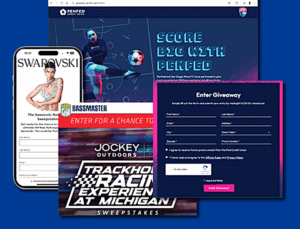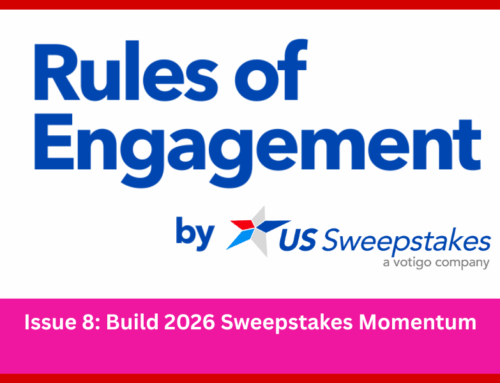The Case for Planning Ahead
Running successful promotions isn’t about reacting to every opportunity – it’s about being ready for the right ones.
When you plan in advance, you give each campaign purpose and direction. Every activation has a job to do – whether it’s building awareness, collecting data, or driving sales – and together, they create lasting impact.
A smart plan turns creativity into consistency. It ensures that every giveaway or sweepstakes supports measurable business goals rather than one-time engagement spikes.
Step 1: Set Objectives That Matter
Start by defining what success looks like. Are you aiming to grow your first-party database, reward loyalty, drive product trials, or strengthen brand trust?
Clear objectives determine everything that follows – from entry mechanics and prize strategy to data collection methods and compliance requirements. When you lead with purpose, every campaign becomes a step toward your larger marketing vision.
Step 2: Structure Your Year Around Momentum
Successful promotion planning starts with rhythm, not reaction. Each campaign should build on the last – keeping your audience engaged and your brand visible all year long.
Think of your promotion calendar as a cycle of growth and engagement:
- Kickoff Periods – Launch initiatives that inspire fresh starts and sign-ups.
- Growth Phases – Introduce contests or sweepstakes that expand awareness and capture first-party data.
- Engagement Seasons – Use loyalty programs, UGC, or polls to deepen connections.
- Peak Sales Moments – Activate instant-wins or multi-channel campaigns that drive conversion.
This framework helps you plan proactively – balancing high-impact campaigns with always-on engagement that keeps your audience involved between major pushes.
Step 3: Pair Promotions and Timing
Q1: Build Data and Early Engagement
- January: New Year promotions that inspire fresh starts and participation – great for loyalty enrollments and first-party data collection.
- February: Valentine’s Day giveaways or themed sweepstakes that encourage sharing and connection. Use social tie-ins or influencer partnerships to extend reach.
- March: St. Patrick’s Day or spring-themed activations – try quizzes, spin-to-win games, or referral campaigns to add a playful element while capturing valuable insights.
Q2: Expand Reach and Strengthen Relationships
- April: Launch Easter or eco-conscious campaigns that highlight renewal or sustainability. Purpose-driven sweepstakes are an effective way to align your brand with shared values.
- May: Mother’s Day storytelling promotions or giveaways that celebrate community and inspire UGC. Focus on emotion and authenticity.
- June: End-of-quarter contests or instant-win programs that drive sales and reward engagement. Automate email and social delivery for consistent participation.
Q3: Engage and Gather Insights
- July: Tap into summer moments with creative campaigns like UGC photo contests or interactive polls that celebrate your audience’s experiences and keep engagement high.
- August: Back-to-School is a natural reset moment. Use promotions that focus on learning, productivity, or preparedness to reach audiences returning to routine.
- September: Transition into fall with preview or feedback campaigns. Gather insights and build anticipation for your upcoming Q4 activations.
Q4: Maximize Results and Celebrate Success
- October: Launch fall or Halloween-themed campaigns that blend fun with engagement – think quizzes, instant-wins, or time-limited sweepstakes that boost visibility.
- November: During Black Friday and Cyber Monday, use gamified sweepstakes or reward-based activations to cut through the noise and capture peak traffic.
- December: End the year with holiday giveaways that express gratitude and reward your community. Focus on retention and customer appreciation as you close out the year.
Step 4: Stay Flexible and Data-Driven
Even the most thoughtful plan will evolve. The strongest marketers treat their calendar as a living document – one informed by data, audience behavior, and new opportunities.
Build quarterly check-ins into your workflow to review performance:
- Which campaigns delivered the best participation rates or ROI?
- What audiences engaged most effectively?
- Where can timing, messaging, or prize strategy improve?
By tracking results and refining along the way, you keep your promotions agile, effective, and performance-driven.
Step 5: Measure the Impact
Tracking the right metrics turns your promotions from activity into strategy. By measuring performance at every stage, you gain clarity on what’s working – and where to optimize.
- Database growth: Monitor entries, email and SMS sign-ups, and loyalty enrollments to assess audience expansion and data quality.
- Engagement: Track participation rates, content submissions, shares, and time spent to understand how deeply audiences are interacting.
- Conversion: Evaluate redemptions, purchases, or offer activations tied to each promotion to measure bottom-line impact.
- Reach: Review referral traffic, social amplification, and organic lift to identify which campaigns extend your brand visibility the most.
When you measure consistently, you create a feedback loop – one that refines strategy, strengthens results, and ensures every campaign delivers measurable business value.
Make 2026 the Year You Plan to Win
Planning your promotions early sets the foundation for measurable success. It gives structure to creativity, ensures time for optimization, and creates space for sustained growth. When every sweepstakes, contest, or instant-win campaign connects to a larger strategy, you’re not just running promotions – you’re building engagement that lasts.
At US Sweepstakes, we help brands bring their promotions to life – from concept and strategy to development, management, and fulfillment. Whether it’s sweepstakes, contests, or digital activations, our team provides the expertise, technology, and support to execute seamlessly and deliver measurable results.
Let’s talk about your 2026 marketing strategy and how to make every campaign count.




